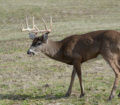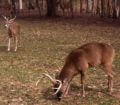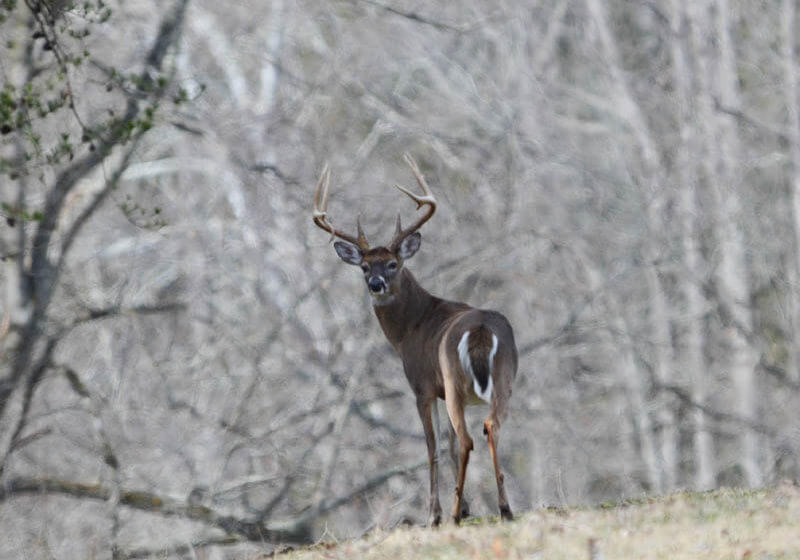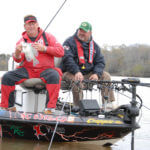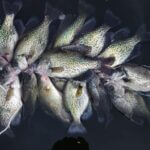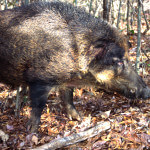John’s Note: When you’re hunting over fields, whether snow fields in Canada or agricultural fields in the South, the same equipment for accurate shooting is required. Only the temperature varies. With a flat-shooting rifle, a quality scope and a cartridge that consistently shoots 1- to 2-inch groups, you can shoot with confidence at ranges of more than 100 yards in pastures and croplands.
 Since you’re so far away from the animal when you take long-distance shots, often the only way a deer detects you is when your human odor rides the wind. You must have the wind in your favor to watch fields and pastures for deer. “I generally have several stands set-up around the agricultural fields and the pastures I hunt,” Tad Brown, the product development manager for Hunter’s Specialties (http://www.hunterspec.com/) and longtime, avid hunter comments. “By having more than one stand, then if the wind’s wrong at my favorite stand, I still have another stand where I can hunt. When hunters spot deer coming into a field from one direction, often they make the mistake of setting-up their stands to only shoot in the direction from which they think the deer probably will enter the field. However, with a wrong wind, this stand will be totally useless.”
Since you’re so far away from the animal when you take long-distance shots, often the only way a deer detects you is when your human odor rides the wind. You must have the wind in your favor to watch fields and pastures for deer. “I generally have several stands set-up around the agricultural fields and the pastures I hunt,” Tad Brown, the product development manager for Hunter’s Specialties (http://www.hunterspec.com/) and longtime, avid hunter comments. “By having more than one stand, then if the wind’s wrong at my favorite stand, I still have another stand where I can hunt. When hunters spot deer coming into a field from one direction, often they make the mistake of setting-up their stands to only shoot in the direction from which they think the deer probably will enter the field. However, with a wrong wind, this stand will be totally useless.”
Brown also chooses specific stands for morning hunting. He explains, “If you’re looking into the sun, oftentimes you won’t be able to see deer slipping through the fence or around the edge of a field because the sun’s blinding you. You also can pick up glare in your riflescope by facing into the sun, which can keep you from shooting accurately.” If you’re hunting over a large field, a pasture, a clear-cut or a powerline right-of-way as Brown does when he’s long-range shooting, a spotting scope drastically can increase your ability to see deer – especially early in the morning and late in the afternoon in low-light conditions. A spotting scope makes the woodlot and fields appear brighter. Also utilizing a spotting scope enables you to remain well away from the deer to keep from spooking them and to watch where the bucks most often enter and exit the field.
 Where to Look for Cropland Bucks:
Where to Look for Cropland Bucks:
When hunting in pastures, green fields, hay fields, wheat fields or any other type of agricultural crops where the foliage is no higher than the buck’s knees, and he’s completely exposed as he crosses a field, you must know where to look for the buck, what he’s going to do and when to take the shot. Brown explains that, “A buck usually will cross a field at the most-narrow point. When he makes the decision to go across the field, generally he’ll move quickly. However, the deer gives you two opportunities to shoot. If you can spot the buck when he’s walking just inside the timber at the edge of the field, often he’ll stop, wait for a few minutes and survey the field before he crosses that open expanse. This time is the best to take your shot. Too, just before entering the timber on the other side of the field, the bucks may stop and look into the woods before they move into the timber. If you take a shot at the buck and miss him when he’s crossing a field, unless the bullet itself startles the deer, you’re generally so far away from the animal, you may get a second shot. Or, if you shoot before the buck crosses the field and miss him, even if he sprints across the field, he’ll often offer you a second shot before he enters the timber on the other side.”
 Brown offers another tactic for stopping bucks crossing a field, even if they move quickly across the field. “I’ll use a grunt call that allows me to keep my hands on my gun and look through my scope at the same time. A buck only may pause for an instant on a field. As soon as you grunt, and the deer stops, put your crosshairs behind the animal’s shoulders, and take the shot. I’ve tried to use conventional grunt tubes. But after I blow them to stop the deer, I have to put the grunt tube down, bring the rifle to my shoulder, find the deer in my scope, put the crosshairs in the kill zone and then take the shot. With the Hunter’s Specialties Slam Talker Deer Call (http://www.hunterspec.com) that you can strap to your arm for hands-free operation, I can follow the deer in my scope, blow the grunt and as soon as the deer stops, I’m ready to shoot. I believe the hands-free type of grunt calls are a definite advantage when hunting bucks in pastures and fields.”
Brown offers another tactic for stopping bucks crossing a field, even if they move quickly across the field. “I’ll use a grunt call that allows me to keep my hands on my gun and look through my scope at the same time. A buck only may pause for an instant on a field. As soon as you grunt, and the deer stops, put your crosshairs behind the animal’s shoulders, and take the shot. I’ve tried to use conventional grunt tubes. But after I blow them to stop the deer, I have to put the grunt tube down, bring the rifle to my shoulder, find the deer in my scope, put the crosshairs in the kill zone and then take the shot. With the Hunter’s Specialties Slam Talker Deer Call (http://www.hunterspec.com) that you can strap to your arm for hands-free operation, I can follow the deer in my scope, blow the grunt and as soon as the deer stops, I’m ready to shoot. I believe the hands-free type of grunt calls are a definite advantage when hunting bucks in pastures and fields.”
To get John E. Phillips’ eBooks and print books on hunting deer, including his newest deer-hunting book, “Whitetail Deer and the Hunters Who Take Big Bucks,” available at http://amzn.to/2bYwYOK/, click on these books to learn more, “How to Hunt and Take Big Buck Deer on Small Properties,” “How to Hunt Deer Up Close: With Bows, Rifles, Muzzleloaders and Crossbows,” “PhD Whitetails: How to Hunt and Take the Smartest Deer on Any Property,” “How to Take Monster Bucks,” “How to Hunt Deer Like a Pro,” and “Bowhunting Deer: Mossy Oak Pros Know Bucks and Bows,” or to prepare venison, “Deer & Fixings.” Or, go to www.amazon.com/kindle-ebooks, type in the name of the book, and download it to your Kindle, and/or download a Kindle app for your iPad, SmartPhone or computer. You also can find John’s books on Nook at www.barnesandnoble.com.
For free information on making jerky from your deer to provide a protein-rich snack, you can download a free book from https://johninthewild.com/free-books.
Next: What Other Crops Deer Prefer to Eat

